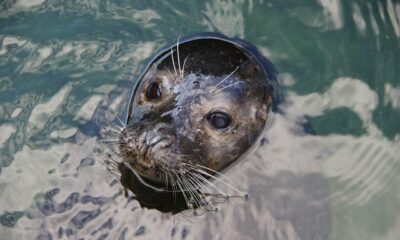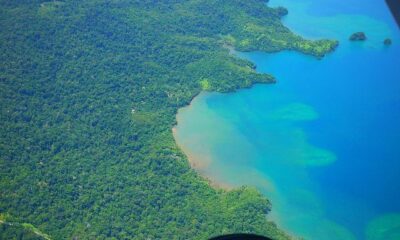

Environment
‘Seismic Shift’ In Shark Conservation Following New CITES Protection
A cause for celebration among Humane Society International’s marine experts as parties voted to give greater protection to thresher sharks, silky sharks and devil rays by listing them all in Appendix II, at the Convention on International Trade in Endangered Species of Wild Fauna and Flora (CITES)
Rebecca Regnery, deputy director of wildlife, Humane Society International issued the following statement:
“Today’s vote to give CITES protections to thresher and silky sharks, reflects a seismic shift in the way the world views and conserves sharks. It indicates that countries recognise the conservation crisis of largely unmonitored international commercial trade in shark products such as fins and meat, leaving many shark species struggling to survive. We are delighted that CITES Parties have acknowledged the urgent need to correct this oversight in order to maintain healthy shark populations, and now we urge them to finalise the adoption of this measure by giving it the green light at the end of this meeting later this week.”
We are delighted that CITES Parties have acknowledged the urgent need to correct this oversight in order to maintain healthy shark populations.
Devil rays are beautiful, defenceless marine animals that have come under increasing serious threat due to demand from Asia for their food-filtering gill plates which are used in ‘medical’ products. Today member countries of CITES have given us hope that they will take the necessary actions to protect angelic devil rays from possible extinction. With this species in serious decline, this decision comes just in time, so we urge countries to approve this measure at the end of the meeting later this week.”
Thresher sharks are one of the most gracefully beautiful types of shark with their long, flowing tail. This has made them a favourite for divers in some countries such as the Philippines. Unfortunately they are also targeted in large number for their meat, fins and other products which are traded commercially. Proper regulation of both fisheries and trade in thresher sharks is an absolute necessity for these species to continue to thrive.
What was the proposal?
This proposal was to include in CITES Appendix II the bigeye thresher shark (Alopias superciliosus), as well as the two other “look-alike” species of the genus Alopias (commonand pelagic threshers) led by Sri Lanka with the following co-proponents: the Bahamas, Bangladesh, Benin, Brazil, Burkina Faso, the Comoros, the Dominican Republic, Egypt, the European Union, Fiji, Gabon, Ghana, Guinea, Guinea-Bissau, Kenya, Maldives, Mauritania, Palau, Panama, Samoa, Senegal, Seychelles and Ukraine.
Thresher shark fast facts:
- Thresher sharks are one of the most threatened of all pelagic shark species.
- The bigeye thresher sharks has the lowest annual rate of population increase of all thresher sharks and is therefore especially at risk of depletion by fisheries.
- Despite bans on catches by regional tuna fisheries agreements in the Atlantic (ICCAT), and Indian (IOTC) oceans, catches reported to the UN FAO have continued to rise in some oceans and have only fallen slightly in others.
- Thresher sharks are listed on Appendix II of the UN Convention on Migratory Species (CMS) and Annex I of the CMS Sharks MoU due to the need for collaboration on international conservation measures of this species.
- Listing on CITES Appendix II would complement these and other fisheries management measures and help curb over-fishing and illegal fishing and trade in this species.
- Trade in sharks that were caught illegally falls under the category of wildlife trafficking.
The silky shark is caught in large numbers in commercial fisheries around the world either on purpose or accidentally when fishing for other species. These catches are traded internationally in unsustainable numbers for their meat, fins and other products. The demand for these products has led to low incentives for adopting fisheries management measures to regulate their catches and to use methods to avoid catching them and resulted in a catch level that must be reduced now in order to prevent further declines in the populations of this vulnerable species.
What was the proposal?
Proposal to include the silky shark (Carcharhinus falciformis) in CITES Appendix II led by the Maldives with the following co-proponents: the Bahamas, Bangladesh, Benin, Brazil, Burkina Faso, the Comoros, the Dominican Republic, Egypt, the European Union, Fiji, Gabon, Ghana, Guinea, Guinea-Bissau, Mauritania, Palau, Panama, Samoa, Senegal, Sri Lanka and Ukraine.
Fast facts about the silky shark:
- Increasing number of silky shark fins are found in the international fin trade despite catches being prohibited by regional fisheries management organizations in both the Atlantic (ICCAT) and the western Pacific (WCPFC) oceans.
- The silky shark is one of the main species that is caught incidentally in tuna fisheries and this especially affects juvenile silky sharks.
- The silky shark is listed on Appendix II of the UN Convention on Migratory Species (CMS) and
- Annex I of the CMS Sharks MoU due to the need for collaboration on international conservation measures of this species.
- Listing on CITES Appendix II would complement these and other fisheries management measures and help curb over-fishing and illegal fishing and trade in this species.
- Trade in sharks that were caught illegally falls under the category of wildlife trafficking.
Mobula (devil) rays
Devil rays are beautiful, defenceless animals that have come under serious threat due to the demand for their gill plates, which they use to filter their food, for use as an Asian medical product. In 2013, CITES member countries agreed to regulate the trade in manta ray gill plates which has further increased the demand for products from devil rays. These rays are in serious trouble if fisheries and trading nations do not start to regulate the trade in these products immediately.
What was the proposal?
This proposal is to include in CITES Appendix II the sicklefin devil ray (Mobula tarapacana)
and spinetail devil ray (Mobula japanica), as well as the seven other “look-alike” species of devil rays (the genus Mobula) led by Fiji with the following co-proponents: the Bahamas, Bangladesh, Benin, Brazil, Burkina Faso, the Comoros, Costa Rica, Ecuador, Egypt, the European Union, Ghana, Guinea, Guinea-Bissau, the Maldives, Mauritania, Palau, Panama, Samoa, Senegal, Seychelles, Sri Lanka, and the USA.
Fast facts about devil rays:
- M. japonica and M. Tarapacana are the two largest species of devil rays with the most valuable gill plates and the highest market demand.
- Fisheries for these species have shifted from limited subsistence fishing to unsustainable commercial fishing to supply the international demand for their gill plates.
- All species are listed on Appendices I and II of the UN Convention on Migratory Species (CMS) and
- Annex I of the CMS Sharks MoU. Full protection and collaboration on international conservation measures are required of member countries of these agreements.
- It is difficult to distinguish between the dried gill plates in trade of the different species of manta and mobula rays.
- Trade in rays that were caught illegally falls under the category of wildlife trafficking.






























